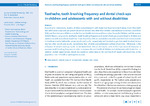Toothache, tooth brushing frequency and dental check-ups in children and adolescents with and without disabilities
Krause, Laura
Seeling, Stefanie
Prütz, Franziska
Wager, Julia
According to international studies, children and adolescents with disabilities have more tooth decay, brush their teeth less often twice a day and use preventive dental services less often than children and adolescents without disabilities. With data from the second follow-up to the German Health Interview and Examination Survey for Children and Adolescents (KiGGS Wave 2, 2014–2017), toothache, tooth brushing frequency and dental check-ups are examined in children and adolescents with and without disabilities. It was found that children and adolescents with disabilities had more toothache in the three months before the survey (23.5% and 15.9%, respectively) and brushed or got their teeth brushed twice a day less often (33.5% and 22.2%, respectively) than children and adolescents without disabilities. Differences in the utilisation of dental check-ups could not be determined. Overall, the results point to the importance of measures to promote tooth brushing frequency in order to improve the oral health of children and adolescents with disabilities. In addition, further opportunities should be created to collect data on the oral health of people with disabilities at the population level in health or participation studies.
Dateien zu dieser Publikation

